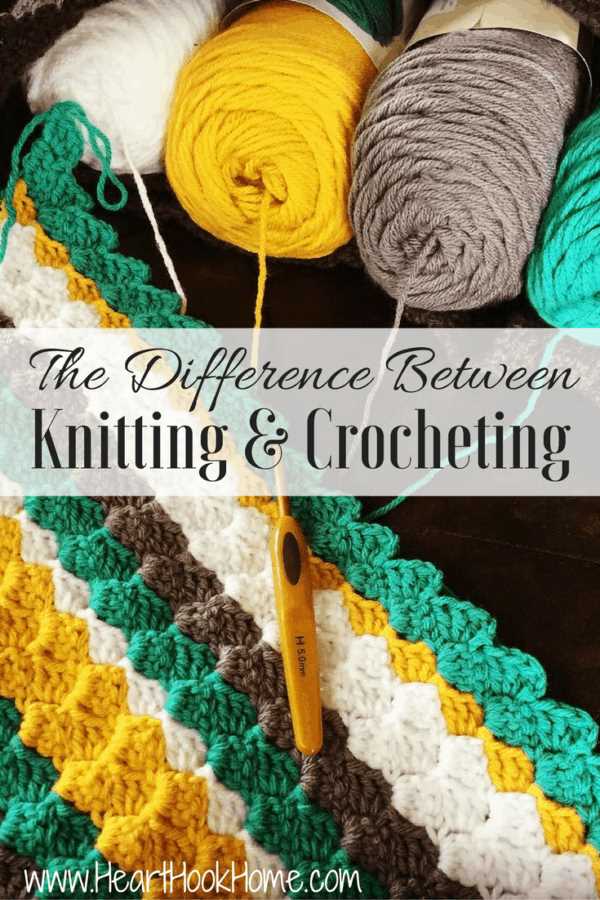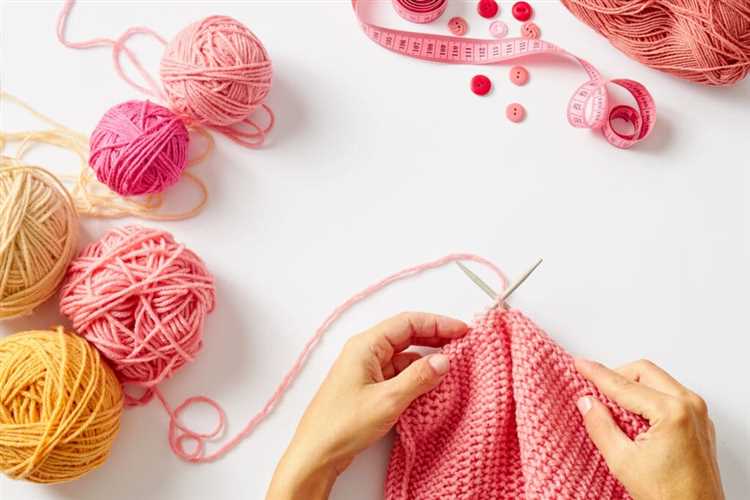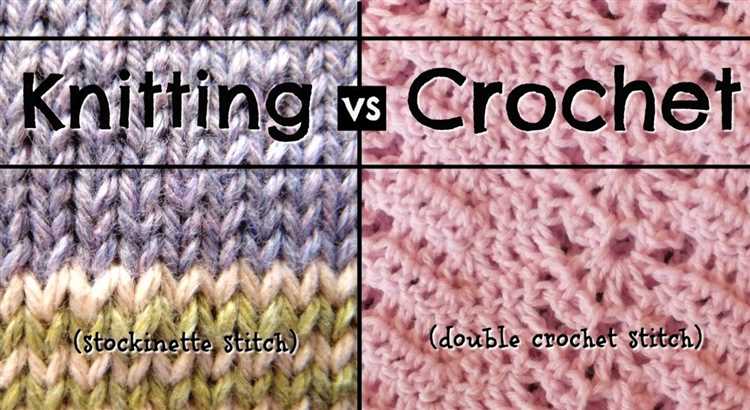Crocheting and knitting are two popular crafts that involve working with yarn and creating beautiful and functional items. While they are often mentioned together, there are some key differences between the two techniques.
Crocheting is a craft that uses a single hook to create stitches in a piece of fabric. It involves interlocking loops of yarn with the hook and creating various patterns and textures. Crocheting is known for its versatility and the ability to create intricate and detailed designs.
Knitting, on the other hand, uses two or more needles to create stitches in a piece of fabric. It involves working with multiple loops of yarn and creating a row of stitches at a time. Knitting is known for its flexibility and the ability to create stretchy and drapable fabrics.
“One of the key differences between crocheting and knitting is the tools used.”
Crocheting often requires a single crochet hook, while knitting requires two or more knitting needles. Additionally, crocheting tends to use thicker yarns and create a denser fabric, while knitting can use a wide range of yarn weights and produce fabrics of various textures.
Despite these differences, both crocheting and knitting offer opportunities for creativity, self-expression, and relaxation. Whether you prefer the versatility of crochet or the flexibility of knitting, both crafts have their own unique benefits and can be enjoyed by crafters of all levels of experience.
The History and Origins
Both crocheting and knitting have rich histories that date back centuries.
Crocheting is believed to have originated in the early 19th century, although some speculate that the craft may have existed as early as the 16th century. The word “crochet” is derived from the French word “croche,” meaning hook. It was primarily practiced by lower-class women during this time and was often used as a way to supplement their income. Crocheted items were affordable and practical, making them popular among the working class.
Knitting, on the other hand, has a longer history that traces back to ancient times. The exact origins of knitting are difficult to pinpoint, but it is believed to have originated in the Middle East or Egypt around the 3rd century AD. Knitting spread throughout Europe during the Middle Ages and became popular among both the upper and lower classes. Knitted garments were considered a luxury and often adorned with intricate patterns and designs.
Over the years, both crochet and knitting techniques have evolved and developed into distinct crafts. Crocheting typically uses a single hooked needle, while knitting uses two pointed needles. Each craft has its own unique techniques and stitches, resulting in different textures and patterns in the finished products. However, both crafts continue to be popular today and are enjoyed by people all over the world.
The Tools and Techniques
Both crocheting and knitting require the use of specific tools and techniques to create beautiful handmade items. Although the end results can often look similar, there are some key differences in the tools and techniques used in each craft.
Crocheting Tools:
- Crochet hook: This is the main tool used in crocheting. It has a hook at one end to pull the yarn through loops.
- Yarn: Crocheting can be done with various types and weights of yarn, depending on the desired outcome of the project.
- Tapestry needle: This needle is used to weave in loose ends and sew pieces together.
Crocheting Techniques:
- Basic stitches: Crocheting primarily involves the use of different stitches, such as single crochet, double crochet, half-double crochet, and more.
- Working in rows or rounds: Crocheting can be done in rows or rounds, depending on the pattern or project.
- Increasing and decreasing: These techniques are used to shape the crocheted fabric by adding or reducing stitches.
Knitting Tools:
- Knitting needles: These come in various sizes and materials, such as metal, bamboo, or plastic. They have pointed ends to help manipulate the yarn.
- Yarn: Knitting also requires yarn, which can vary in weight and fiber content.
- Tapestry needle: Similar to crocheting, a tapestry needle is used in knitting to weave in loose ends and sew pieces together.
Knitting Techniques:
- Basic stitches: Knitting primarily involves the use of two main stitches, knit and purl, which can be combined in different ways to create various patterns and textures.
- Working in rows or rounds: Knitting can be done in rows or rounds, depending on the desired outcome of the project.
- Increasing and decreasing: Similar to crocheting, knitting also incorporates increasing and decreasing techniques to shape the knitted fabric.
Both crocheting and knitting offer endless possibilities for creativity and self-expression. Whether you prefer the simplicity of knitting or the versatility of crocheting, both crafts provide a rewarding and enjoyable experience for enthusiasts of all skill levels.
The Differences in Stitching
When it comes to crocheting and knitting, the biggest difference lies in the different types of stitches that are used in each craft.
Crocheting stitches:
- Single crochet (sc): This is the most basic stitch in crocheting, creating a tight and dense fabric.
- Double crochet (dc): This stitch is taller and looser than the single crochet, producing a more open fabric.
- Half double crochet (hdc): This stitch is shorter than the double crochet but taller than the single crochet.
- Treble crochet (tr): This is the tallest stitch in crocheting, used to create lacy and open fabric.
- Slip stitch (sl st): This stitch is used to join rounds or create decorative edges.
Knitting stitches:
- Knit stitch (k): Also known as the garter stitch, this stitch creates a bumpy texture and visible rows of “V” shapes.
- Purl stitch (p): This stitch is the reverse of the knit stitch, creating a smooth texture and appearing like horizontal lines.
- Stockinette stitch: This stitch is created by alternating knit and purl stitches, resulting in a smooth and flat fabric.
- Ribbing: Ribbing is created by alternating knit and purl stitches in a specific pattern, often used for cuffs and edges.
- Cable stitch: This stitch creates twisted, interlocking patterns, adding texture and complexity to knitted fabric.
These are just a few examples of the stitches used in crocheting and knitting. Depending on the pattern and design, crafters can experiment with various combinations and techniques to create unique and beautiful projects.
The Versatility of Crocheting
Crocheting is a versatile craft that allows for a wide range of project possibilities. Whether you’re creating clothing, accessories, or home decor items, crocheting offers endless possibilities for personal expression and creativity.
One of the primary advantages of crocheting is its ability to create intricate and detailed designs. With just a hook and yarn, crocheters can produce beautiful lacework, intricate patterns, and delicate motifs. This level of detail is especially useful when creating decorative items such as doilies, tablecloths, and bedspreads.
Crocheting is also well-suited for creating three-dimensional objects. By using different stitch techniques and shaping methods, crocheters can produce items such as stuffed animals, amigurumi toys, and three-dimensional sculptures. The ability to create these three-dimensional objects adds a unique dimension to crocheting and allows for even more creativity.
Unlike knitting, crocheting also offers the flexibility to easily change colors within a project. With knitting, changing colors can be more complicated and time-consuming. However, with crocheting, it’s relatively simple to switch between colors, creating bold and vibrant color patterns in your work.
Another advantage of crocheting is its portability. Crochet hooks and yarn are compact and lightweight, making them easy to carry around. This portability allows crocheters to work on their projects while on the go or in various settings, such as during travel or while waiting in line.
Crocheting is also a craft that can be enjoyed by people of all ages and skill levels. Whether you’re a beginner or an experienced crocheter, there are patterns and projects available for every skill level. The simplicity of the crochet stitch makes it accessible to beginners, while advanced crocheters can challenge themselves with more complex techniques and patterns.
Overall, the versatility of crocheting makes it a popular craft choice for many. From delicate lacework to intricate three-dimensional creations, crocheting offers endless possibilities for creativity and personal expression. So grab a hook, some yarn, and get ready to explore the endless world of crocheting!
The Versatility of Knitting
Knitting is a versatile craft that offers a wide range of possibilities for creating unique and functional items. Whether you want to make clothing, accessories, or home decor, knitting provides endless opportunities to showcase your creativity.
One of the main benefits of knitting is the ability to create intricate and detailed patterns. With a set of knitting needles, yarn, and a little bit of skill, you can bring complex designs to life. From intricate lace shawls to colorful Fair Isle sweaters, the possibilities are limited only by your imagination.
Knitting is also a great way to create customized clothing and accessories. By choosing your own yarn and pattern, you can create one-of-a-kind pieces that reflect your personal style. Whether you prefer cozy scarves and hats or elegant cardigans and dresses, knitting allows you to express your individuality.
In addition to creating wearable items, knitting can also be used to make home decor. From cozy blankets and pillows to decorative dishcloths and coasters, knitting can add a touch of handmade charm to any room. By choosing colors and patterns that complement your decor, you can create beautiful and functional pieces that make your house feel like a home.
Furthermore, knitting is a portable craft that can be enjoyed almost anywhere. Whether you’re waiting for an appointment or traveling on a long journey, knitting can keep your hands busy and your mind relaxed. The compact size of knitting needles and yarn makes it easy to carry your project with you, allowing you to make progress on your creations whenever inspiration strikes.
Knitting also offers a sense of accomplishment and satisfaction. The process of transforming a ball of yarn into a finished item can be incredibly rewarding, and seeing the results of your hard work can boost your self-esteem and confidence. Whether you’re a beginner or an experienced knitter, each completed project is a testament to your skills and creativity.
In conclusion, knitting is a versatile craft that allows you to create unique and functional items. From intricate patterns and customized clothing to home decor and portable projects, knitting offers endless possibilities. Whether you’re a beginner or an experienced knitter, the versatility of knitting ensures that there is always something new to learn and create.
The Types of Projects in Crocheting
Crocheting offers a wide range of project options, allowing you to create various items for yourself, your home, or as thoughtful gifts. Here are some common types of projects you can embark on:
- Apparel: Crocheting allows you to make beautiful and unique garments such as sweaters, cardigans, hats, scarves, and shawls. With different stitches and yarn choices, you can create items suitable for different seasons and occasions.
- Home Decor: Crocheted home decor items can add a cozy and personal touch to your living space. You can make throws, pillows, blankets, table runners, and even curtains using various crochet techniques and patterns.
- Toys and Amigurumi: Crocheted toys and amigurumi (Japanese art of crocheting stuffed animals or small knitted toys) are popular projects for both children and adults. From cute stuffed animals to keychain accessories, the possibilities are endless.
- Bags and Accessories: Crocheting allows you to create stylish bags, purses, backpacks, and other accessories. You can experiment with different yarn weights and colors to match your personal style.
- Blankets and Afghans: Crocheting large blankets and afghans allows you to showcase your skills and creativity. You can choose from various patterns and motifs to create a cozy and warm blanket for yourself or as a thoughtful gift.
- Seasonal and Holiday Items: Crocheting offers a fantastic opportunity to create festive items for different holidays and seasons. You can make Christmas ornaments, Easter decorations, Halloween costumes, and more.
These are just a few examples of the projects you can tackle in crocheting. With practice and creativity, you can explore and create endless possibilities with this versatile craft.
The Types of Projects in Knitting
Knitting is a versatile craft that allows you to create a wide range of projects. Whether you’re a beginner or an experienced knitter, there are projects for every skill level and interest. Here are some common types of knitting projects:
- Scarves and Cowls: Scarves and cowls are popular knitting projects for beginners. They are simple and quick to knit, making them a great way to practice basic stitches.
- Hats: Knitting hats is another common project for knitters of all levels. From simple beanie styles to more intricate cable patterns, hats can be customized to suit your personal style.
- Sweaters and Cardigans: Sweaters and cardigans are more advanced knitting projects that require knowledge of shaping, seaming, and more complex stitch patterns. They offer a rewarding challenge for experienced knitters.
- Socks: Knitting socks can be a fun and practical project. They can be knit using different techniques, such as top-down or toe-up, and in a variety of stitch patterns.
- Blankets: Knitted blankets make cozy and comforting additions to any home. They can be knit in different sizes, from baby blankets to large afghans, and in various stitch patterns.
- Shawls: Shawls are versatile accessories that can be worn in different ways. They can be knit using lace, colorwork, or textured stitch patterns, offering endless possibilities for creativity.
- Toys and Amigurumi: Knitting toys and amigurumi (small crocheted or knitted stuffed toys) allows you to create cute and whimsical characters. They make great gifts for children and collectors alike.
These are just a few examples of the types of projects you can create through knitting. Whether you’re looking for a quick and easy project or a more challenging endeavor, knitting offers a wide range of possibilities for creativity and self-expression.
The Popularity and Modern Trends
Crocheting and knitting have both experienced a resurgence in popularity in recent years. This can be attributed to several factors:
- Therapeutic Benefits: Many individuals find crocheting and knitting to be calming and stress-relieving activities. The repetitive motions and focus required help to alleviate anxiety and promote relaxation.
- Creativity and Self-expression: Crocheting and knitting allow individuals to express their creativity and create personalized items. With a vast range of yarns and patterns to choose from, crafters can design unique pieces that reflect their personal style.
- Social Connection: Crocheting and knitting communities have emerged both online and offline, providing crafters with a sense of belonging and connection. Crafters can join local knitting groups, attend workshops, or participate in online forums and social media groups to share ideas, tips, and completed projects.
- Sustainable and Eco-friendly: In an era where sustainability is valued, crocheting and knitting offer a way to reduce waste and support eco-friendly practices. By repurposing old garments into yarn or using natural and sustainable fibers, crafters can contribute to a more sustainable lifestyle.
In addition to their renewed popularity, crocheting and knitting have also seen modern trends emerge:
- Chunky Knits: Oversized and chunky knitted items have gained popularity in home decor and fashion. These cozy, textured pieces add warmth and a touch of luxury to any space or outfit.
- Amigurumi: Amigurumi is a Japanese art form specializing in crocheted or knitted stuffed animals and characters. This trend has taken the crafting world by storm, with crafters creating adorable and intricate creatures.
- Colorful Yarns and Ombre Effects: Bold and vibrant colors have become more popular, with crafters experimenting with ombre effects and gradient yarns. This allows for stunning color transitions and adds visual interest to projects.
- Modern Patterns: While traditional patterns are still popular, modern patterns with minimalist designs and contemporary aesthetics are gaining attention. These patterns often feature clean lines, geometric shapes, and simple color palettes.
Overall, the popularity of crocheting and knitting continues to grow, and modern trends contribute to their appeal by offering new ways for crafters to express their creativity and stay up-to-date with the latest styles.
FAQ:
What is the difference between crocheting and knitting?
Crocheting and knitting are two different techniques for creating fabric with yarn or thread. The main difference is the tools and techniques used. Crocheting uses a single hooked needle to create stitches, while knitting uses two straight or circular needles to create loops of yarn.
Which technique is easier to learn, crocheting or knitting?
Many people find crocheting easier to learn than knitting, as it requires only one hook and uses simpler stitches. Knitting can take a bit more practice to get the hang of, as it involves working with two needles and manipulating loops of yarn.
Can you use the same patterns for crocheting and knitting?
No, crocheting and knitting use different stitch techniques, so the patterns are not interchangeable. However, there are many patterns available for both crocheting and knitting, so you can find a wide variety of options for each technique.
Which technique is faster, crocheting or knitting?
The speed of crocheting and knitting can vary depending on the individual and the project being worked on. In general, crocheting tends to be faster, as it requires fewer steps to create each stitch. However, experienced knitters can also work quickly, especially with more complex patterns.


